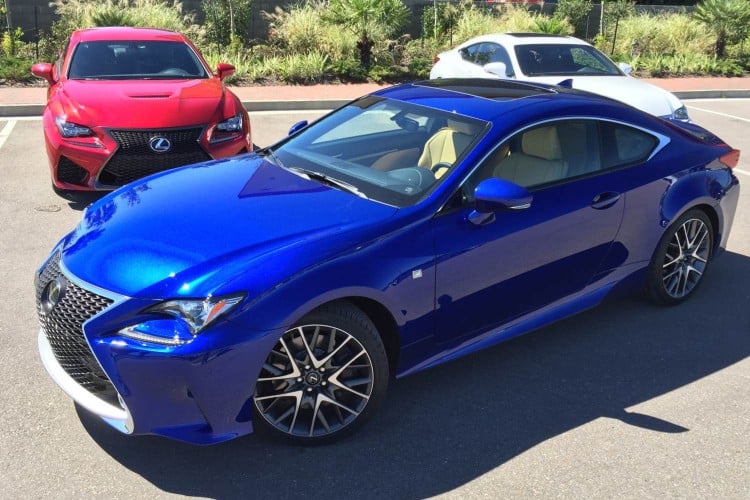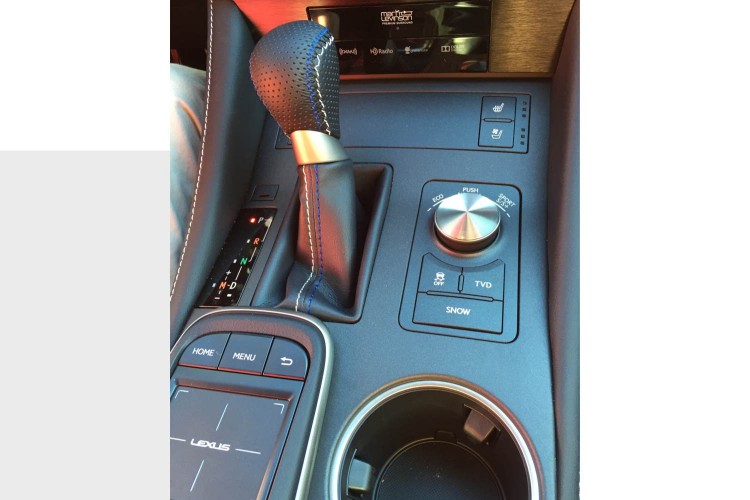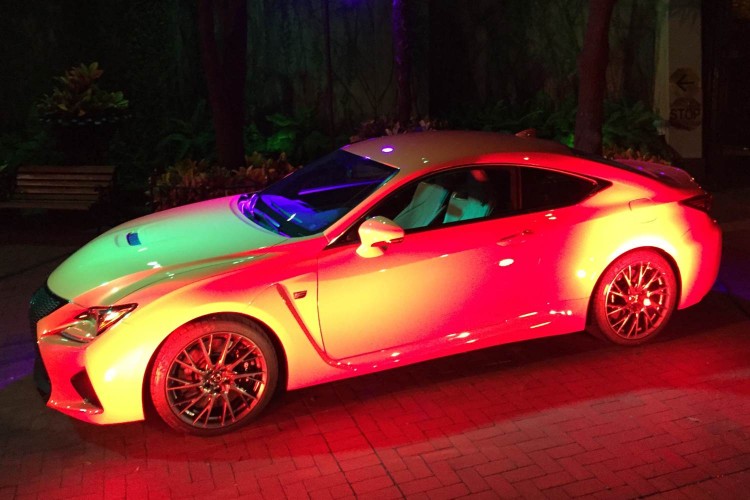What do you get when you cross a Lexus GS, IS and IS convertible? The all-new 2015 Lexus RC 350. Toss in a generous helping of IS F and you get the RC F performance coupe from the luxury division of Toyota. Lexus launches its RC line this fall, its first new coupe model in 15 years…and it’s a winner.
I just returned from the regional launch for this new “Radical Coupe” where Lexus introduced the RC 350 in base coupe and F Sport variants powered by a peppy 306hp V-6 engine, and the radical, ballsy RC F complete with new 467hp 5.0-liter V-8 under the hood. Lexus is pitting the cars squarely at the heart of the German competition that includes Audi A5 and RS5, BMW 4-series and M4 and Mercedes-Benz C350 and C63 AMG coupe models.
The new RC cars feature the new spindle grille face of Lexus and take design inspiration from the LFA supercar. Buyers can get the RC 350 in rear- or all-wheel drive but the RC F arrives with power only going to the rear tires. Vehicles sent out the door with RWD get an eight-speed automatic gearbox while the AWD cars see the engine mated to a six-speed unit. I feel sorta bad for my colleagues in the snowbelt states that will order their rides with four tires spinning on snow and ice as the RWD cars we tested in NOLA were really impressive (and that ain’t Bourbon Street talking either).
The car is based on a truly rigid platform utilizing the front end of the GS sedan, the rear elements of the IS sport sedan and the passenger compartment of the IS convertible for its enhanced strength. The RC was designed and built to be a coupe widening the choice of discerning luxury coupe buyers who require more than a sedan with two doors removed. RC is set up as in 2+2 seating although the rearseat legroom is quite limited.
RC 350
The “base” car is the RC 350 and as I mentioned is available in RWD or AWD platforms. Each are powered by the latest version 3.5-liter V-6 Lexus engine that generates 306hp and 277 lb. ft. of torque in this application. Fuel economy is expected at 19 mpg city and 28 mpg highway with the RWD car and knock a tick or two off for AWD cars. The new eight-speed auto tranny with Sports Program Direct Shift behind this engine is a work of art and can be operated in Normal, Sport and Manual modes. In Sport mode the Lexus technology adds G-sensor AI-Shift control that uses the vehicle’s g-sensors to tell it which gear would be optimum in the given driving situation.
Drive Mode Select allows drivers to choose from Eco (boring), Normal (still boring) and Sport S. I highly recommend the latter two mode that enhances steering, suspension and throttle controls systems for more enjoyable travels. Lexus gives RC 350 buyers a choice of 18- and 19-inch wheels and tires.
RC 350 F Sport
For those not quite satisfied with the base RC 350, Lexus offers the F Sport package that adds another drive mode (Sport S+), Adaptive Variable Suspension and Lexus Dynamic Handling with Dynamic Rear-wheel Steering. Rear wheel steering enhances handling control in the RC and works by turning in the opposite direction of the front tires at lower speeds and angle in the same direction as the fronts at highway speeds. F Sport also adds unique wheels, bigger brakes and special trim touches including brushed aluminum pedals and signature F stitching and badging.
F-Yeah
Truth be told, the car we all really wanted to drive was the RC F and Lexus did not disappoint as we were allowed generous track time at the NOLA Motorsports facility (that will be hosting an Indy Car race next spring). The 2015 RC F takes what began with the IS F sedan a few years ago and rebuilt the engine and dropped it into a true sports car chassis built to take the punishment delivered by the powertrain (and the journalists). RC 350 and RC 350 F Sport are the enthusiast cars but RC F is the driver’s car and should come with tickets to a performance driving school and ample track time.
The F stands for Fuji, the speedway in Japan where Toyota motorsports are brought to life. There are a few other “F” words that were uttered in reference to this gorgeous new ride from Lexus ranging from fun to freakin’ – as in awesome.
Thanks to the engineering team that gave the V-8 new heads, higher revs and lighter internal components, RC F cranks out 467 ponies and 389 lb. ft. of torque. To handle this extra power and the demands drivers will throw at their F cars, Lexus has given this chassis additional bracing and supports and upgrades the double wishbone front and independent multilink rear suspension gear. Another little “trick up their sleeve” from Lexus engineers is the Active Sound Control that works in Sport S+ drive select mode to enhance the natural growl of the V-8’s intake and exhaust. Fuel economy is estimated at 16 mpg city and 25 mpg highway.
This engine is mated with the SPDS 8-speed gearbox that operates in Normal, Sport S, Sport S+ and Manual modes and Sport S engages the G-sensor AI Shift Control. For the rare times one takes the RC F out on a track there is Sport S+ that offers quicker downshifts and automatic downshifting (and engine speed rev matching) during hard braking. Speaking of brakes, the front rotors on the RC F are nearly 15 inches in diameter and feature six-piston calipers, with four-piston calipers in the rear.
Distributing power to the rear wheels is a Torsen limited slip differential as standard equipment but Lexus is offering a Torque Vectoring Differential that uses electric motors at the rear gearbox to apply power to the wheel that it determines will propel the vehicle through a corner faster, continuously changing to the varying conditions including throttle input and vehicle position and angle. TVD offers three settings of Standard, Slalom and Track operating modes.
Drivers seeking stability at speeds over 50 mph will appreciate the speed-activated rear wing built designed into the trunklid. It will automatically deploy above 50 and settle back into place when the vehicle slows to 25. Should drivers wish to raise the wing on their own they can simply push a button on the dash panel to the left of the steering column.
Lexus offers a choice of three forged aluminum 19-inch wheels in five-, ten- and 20-spoke design for this car and for those wishing to enhance the track attributes of their new coupe the automaker offers a carbon fiber reinforced roof panel and rear wing.
Functional Design
The new RC and RC F look fast even when sitting still. The RC 350 is actually a bit more slippery in the wind tunnel than the RC F as the beefier car gets slightly wider fenders, rides a little lower and needs a little rise in the hood to accommodate that larger engine. RC F features a heat extractor grille in the forward portion of the hood with additional heat outlets behind the front tires. The black mesh in the face of the RC F is more massive than in the RC 350 and all cars feature additional cooling ducts in the front fascia.
The RC cars get LED headlighting with separate L-themed daytime running lamps and that theme is continued at the rear as designers gave RC unique taillamps with a 3-D effect. New fog lamps have been developed for the RC line using LED lights.
The interior is laid out in a cockpit configuration with all the pertinent controls within easy reach of the driver. Lexus brings its latest technology and materials into the RC line including touchpad technology to control the infotainment system (with haptic feedback) and digital color screens in the instrument panel and high atop the center stack.
And then there are the seats. Even the base RC 350 gets supportive, bolstered, powered front seating in a new design and wrapped in leather. RC F models get a gorgeous new sport bucket seat that looks like it came from a very pricey Italian car that function every bit as good as they look. Heating and ventilation is offered across the model lineup.
Drive Time
Lexus made RC 350 F Sport and RC F test vehicles available for us to drive on surface roads and highways around the NOLA Motorsports facility and RC F models were presented for track use. Sadly, no base RC 350 models were around but we drove the F Sport in Eco and Normal modes to simulate that driving experience and we are happy to report no one left disappointed.
We first hopped into the beautiful new Infrared RC F for some time on the local streets that found us making a driver swap at one of the southern Louisiana’s beautiful and historic plantations with the Spanish Moss dripping from the massive Oak tree branches. RC F is great as a daily driver. The seats are comfortable yet supportive and the car is a breeze to drive. The new electric power steering provides a firm feel yet low-speed maneuvers such as parking are effortless. The car is quiet and comfortable and handles any road condition tossed its way.
I next took out one of the RC 350 F Sport models and found the driving experience to be very Lexus-like in that the vehicle absorbs all the negativity the outside world throws at it and bathes driver and occupants in a spa-like atmosphere (massage not included). And that Mark Levinson sound system is incredible. Some 17 speakers and 835 watts put you front and center in the studio or concert hall and the new Clari-Fi technology restores the sound quality that is compressed in typical music downloads these days.
Acceleration behind the V-6 is very good and more than enough for most of RC buyers. The new V-8, and its 467hp, is just fabulous but demands responsibility from drivers as this powertrain may invite attention from law enforcement officials.
Track Time
Anybody can drive fast but rarely is that being responsible (or safe). Taking the new Lexus coupe out on a two-and-a-half-mile road course is not only responsible but damned good fun.
After a couple of acclimation laps we were cut loose to blast the RC F around the track to demonstrate just how capable this car is. Lexus engineers have outdone themselves as this is just about as much fun as one can have in a car they drive off the showroom floor and right onto the track.
These cars we were driving were shod with the factory-supplied rubber in the form of the Michelin Pilot Sport PS2 and they stuck to the course like glue. I had always heard from driving instructors that a squealing tire is a happy tire and believe me, there were plenty of happy tires during my time around the course.
During my numerous runs I swapped between RC F models with the base Torsen differential and cars with the new Torque Vectoring Differential. They drove around the corners a bit differently and at first I preferred the Torsen car as its handling style was more familiar to me but as the day progressed I came to truly enjoy the TVD cars as I saw my lap times diminish with that new technology. With the TVD the car handles better but the rear rides a bit different and once you get used to the way the back-end settles in you find yourself begging for more speed as you twist the steering wheel left and right.
Pricing
The 2015 Lexus RC 350 will start at a base MSRP of $42,790 ($45,025 for AWD) and Lexus anticipates annual sales of around 15,000 units. RC F sees a starting point of $62,400 with some 2,500 units leaving dealers each year. The cars we tested did not have specific price breakdowns with them as that information will be available when vehicles arrive in showrooms next month, as will the EPA ratings.
The new RC from Lexus is quite the car. It joins a small segment of vehicles across the globe that don’t typically account for high sales volumes but they bring a lot of press and a lot of impressions to their brands. These are the “halo” cars that automakers rally around, the cars they dangle in front of us to inspire us to dream big but when reality sets in we purchase one of the cars sitting off to the side of this one on the showroom floor.
The 2015 Lexus RC 350, and especially the RC F, are aspirational cars that drivers will reward themselves with when life permits. Lexus has done a very nice job in bringing its next coupe to market in an attractive exotic-like package while keeping it attainable for so many. No snobbery, no foolishness, the new RC brings it.
















